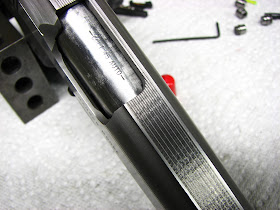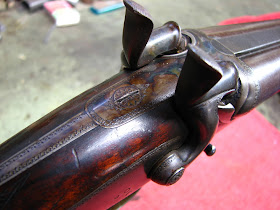Lititz, PA 717-626-4226 Dewey@VicknairRestorations.com
Friday, June 16, 2017
Why a Custom 1911 is So Expensive
Anyone who is into shooting knows that a custom 1911 can consume quite a bit of lira. In this post I'll show you where at least some of that cost goes. I won't bother showing things like frame/slide fit, barrel fitting, extractor shaping/tuning or any other internal work since those aren't very photogenic processes. Those are obviously all done as they are the basis of a truly accurate and reliable 1911, but for this post I'll concentrate on the visible items.
We'll start with the frame. A beavertail grip safety is a given on any custom 1911 since not only does it offer a larger surface area over which to distribute recoil, it also offers a much higher grip on the pistol when fitted correctly. Moving the hand closer to the bore axis greatly aids in controlling muzzle flip. Some "custom" pistols exhibit less than perfect fitting of this part to the frame. Less than perfect is unacceptable when a client is paying the kind of money that this costs.
Let's get on with this part. There are "filing jigs" commercially available to facilitate filing the frame horns to accept the grip safety. The problem is that when one of these is used, it invariably results in unsightly gaps where the part meets the frame. All beavertail safeties are investment cast and the internal contours and radii are never perfect. The first action item is to true the internal radius of the grip safety, otherwise it can never be fitted seamlessly to the frame.
After the frame horns are cut and roughly contoured, the smoking and filing begins. This is no different than blacking the barrels down or inletting the stock on a fine shotgun. It takes MUCH longer than using a filing jig but the results are well worth the effort.
Once this part of the job is done, the external fitting can begin. I always think of just about all aftermarket "custom" parts as blanks to be finished by the gunsmith.
With the barrel and bushing properly fitted, the rear of the slide was filed and polished to perfectly mate with the back of the frame when the slide is in battery. The extractor and ejector are installed for this operation as they form part of the rear contours. The top of the slide was serrated, cuts for Novak front and rear sights are made (a Kensight adjustable is used) and the slide is treated to a decorative border at the topside and beveling on the bottom edges. The front strap was serrated (20 lpi) in a diamond pattern (this client's preferred design) and material was removed behind the triggerguard to facilitate a higher grip. The final frame modifications are a beveled mag opening and trued contours.
The finished job.
We'll start with the frame. A beavertail grip safety is a given on any custom 1911 since not only does it offer a larger surface area over which to distribute recoil, it also offers a much higher grip on the pistol when fitted correctly. Moving the hand closer to the bore axis greatly aids in controlling muzzle flip. Some "custom" pistols exhibit less than perfect fitting of this part to the frame. Less than perfect is unacceptable when a client is paying the kind of money that this costs.
Let's get on with this part. There are "filing jigs" commercially available to facilitate filing the frame horns to accept the grip safety. The problem is that when one of these is used, it invariably results in unsightly gaps where the part meets the frame. All beavertail safeties are investment cast and the internal contours and radii are never perfect. The first action item is to true the internal radius of the grip safety, otherwise it can never be fitted seamlessly to the frame.
After the frame horns are cut and roughly contoured, the smoking and filing begins. This is no different than blacking the barrels down or inletting the stock on a fine shotgun. It takes MUCH longer than using a filing jig but the results are well worth the effort.
Once this part of the job is done, the external fitting can begin. I always think of just about all aftermarket "custom" parts as blanks to be finished by the gunsmith.
With the barrel and bushing properly fitted, the rear of the slide was filed and polished to perfectly mate with the back of the frame when the slide is in battery. The extractor and ejector are installed for this operation as they form part of the rear contours. The top of the slide was serrated, cuts for Novak front and rear sights are made (a Kensight adjustable is used) and the slide is treated to a decorative border at the topside and beveling on the bottom edges. The front strap was serrated (20 lpi) in a diamond pattern (this client's preferred design) and material was removed behind the triggerguard to facilitate a higher grip. The final frame modifications are a beveled mag opening and trued contours.
The finished job.
A Custom S&W Model 10
This revolver started life as a 6-inch, pencil barrel, fixed sight, square butt. It's been modified into a 3-inch, heavy barrel, adjustable sight revolver for IDPA "Back Up Gun" class competition.
The heavy barrel that was used was from a 4-inch model. I cut and crowned the barrel and after fitting it to the frame and establishing the front gauge (after aligning the crane and setting the rear gauge), a new forcing cone was cut. The problem with fitting a heavy barrel to a pencil barrel frame is that the frame lacks the ribbed front portion that mates to the rib of the heavy barrel. To correct this, I machined a portion of the heavy barrel rib away, leaving the barrel round where it interfaces with the frame. The original rib was left at the forward portion of the barrel to serve as a front sight base. A dovetail was machined for the front sight. The frame was machined to accept a factory adjustable rear sight and the sight was contoured to match the frame. The balance of the work consisted of: chamfering and numbering the chambers, smoothing the action (7 lb. DA), installing an overtravel stop and making the fiber-optic front sight. The cylinder latch thumbpiece was undercut for speedloader clearance and the frame was converted to round butt configutation. Finally, everything except the hammer and trigger were slow rust blued. I don't know whose make the grips are as the client supplied them.
Here are the photos.
The heavy barrel that was used was from a 4-inch model. I cut and crowned the barrel and after fitting it to the frame and establishing the front gauge (after aligning the crane and setting the rear gauge), a new forcing cone was cut. The problem with fitting a heavy barrel to a pencil barrel frame is that the frame lacks the ribbed front portion that mates to the rib of the heavy barrel. To correct this, I machined a portion of the heavy barrel rib away, leaving the barrel round where it interfaces with the frame. The original rib was left at the forward portion of the barrel to serve as a front sight base. A dovetail was machined for the front sight. The frame was machined to accept a factory adjustable rear sight and the sight was contoured to match the frame. The balance of the work consisted of: chamfering and numbering the chambers, smoothing the action (7 lb. DA), installing an overtravel stop and making the fiber-optic front sight. The cylinder latch thumbpiece was undercut for speedloader clearance and the frame was converted to round butt configutation. Finally, everything except the hammer and trigger were slow rust blued. I don't know whose make the grips are as the client supplied them.
Here are the photos.
Wednesday, June 14, 2017
An Alex Henry .500 BPE
This somewhat plain but very well made Alex Henry hammer double rifle needed a thorough cleaning, a new breech screw and an extractor retaining screw. One of the stalking safeties was binding and that was also corrected. The black powder express rifles were generally much less massive than their nitro express counterparts and this one is no exception. It is very slender, with a frame about the size of that of a 28 gauge gun. It packs quite a lot of punch into such a petite package.
Sunday, June 11, 2017
Another Modern Revolver
Another Ruger Security-Six, owned by the same client as the blued version shown in an earlier blog post. This one started as a stainless, square butt, six inch barreled "warning era" version, meaning that the left side of the barrel was roll-stamped with an entire paragraph, basically admonishing one to not be a doofus when handling a firearm. This one got much the same treatment as its blued sibling.
- The warning was removed from the barrel.
- The barrel was cut to 5 inches, recrowned and machined to accept a Bowen ramp sight base.
- The hammer spur was welded up and reshaped to a Python-esque form and hand checkered at 20 lpi.
- All contours were sharpened or created whole, since all Rugers come from the factory looking like they were attacked by a gunsmith school dropout with a buffing wheel setup.
- GP100 style flute cut into right recoil shield.
- Flattened the pot belly look at the forward bottom of the frame/yoke.
- Cylinder latch thumb pad hand checkered at 30 lpi.
- Cylinder turned true, beveled at the front, decorative ring turned at the rear and chambers chamfered.
- Tuned action with trigger stop.
- Recontoured, smooth faced trigger.
- Serrated rear sight base.
- Round butt conversion.
- All roll pins were replaced with solid, domed pins.
- Satin glass bead blasted finish with polished hammer and trigger.
- Reshaped and refinished Herrett's stocks.
Here are a few photos of the process of sharpening up the frame contours.
The finished job.
- The warning was removed from the barrel.
- The barrel was cut to 5 inches, recrowned and machined to accept a Bowen ramp sight base.
- The hammer spur was welded up and reshaped to a Python-esque form and hand checkered at 20 lpi.
- All contours were sharpened or created whole, since all Rugers come from the factory looking like they were attacked by a gunsmith school dropout with a buffing wheel setup.
- GP100 style flute cut into right recoil shield.
- Flattened the pot belly look at the forward bottom of the frame/yoke.
- Cylinder latch thumb pad hand checkered at 30 lpi.
- Cylinder turned true, beveled at the front, decorative ring turned at the rear and chambers chamfered.
- Tuned action with trigger stop.
- Recontoured, smooth faced trigger.
- Serrated rear sight base.
- Round butt conversion.
- All roll pins were replaced with solid, domed pins.
- Satin glass bead blasted finish with polished hammer and trigger.
- Reshaped and refinished Herrett's stocks.
Here are a few photos of the process of sharpening up the frame contours.
The finished job.



















































